First Aid Kit Aboard, by a Boat Mom and RN. Supplies and Organization.

Here is what to purchase for your first aid kit aboard. I have organized it by medical issue. As a liveaboard mom and a registered nurse, I believe this is a well-built kit.
Even though I am a nurse, cruising on a sailboat with my family, does not provide any of the hospital supplies, or equipment I have been trained to use.
Most of what I can do on a boat, any parent can do too, with some simple training.
Before I forget, I have a lot more essential and everyday boating items:
Boat Gear Page @ No Texting and Tacking
I am also covering what we do not have aboard and why I chose not to buy.
Note: These are suggestions we have found useful for our family. This post is not intended to provide medical advice. For any questions and advice, please, contact your provider.
How to Obtain Medications and Supplies
All OTC (over-the-counter) supplies and medications can be ordered online and are found in any drug store.
Here are a few helpful posts about other boating essentials:
12 Safety Gear Essentials for the High Seas.
10 Most Reliable Sailing Life Jackets (Adults and Kids)
13 Gadgets for Boaters
27 Important Tools for Boaters
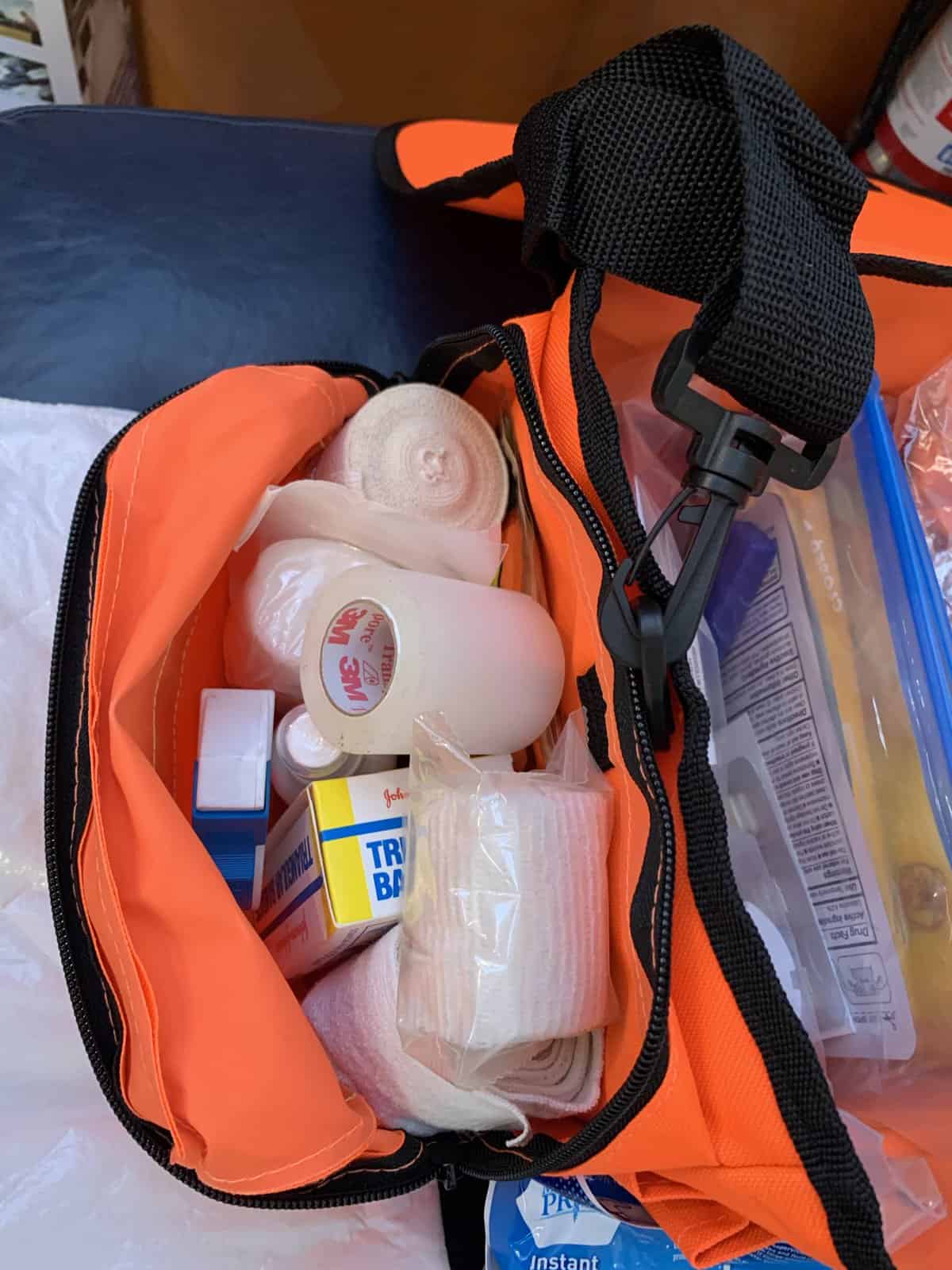
For prescription medications, reach out to your providers and share your travel plans. They should be able to prescribe any major antibiotic, ointments and other necessary items.
Almost all foreign countries, offer everything you might need, the pharmacists are very helpful and a doctor’s visit is much, much, much cheaper, than the US ones.
What We Have Aboard
I have organized our supplies based on body parts and types of troubles.
I am also including links to order everything you see in the pictures.
Cuts, Wounds, Bleeding and Burns
The majority of cruising families end up only needing band-aids.
And it was the band-aids I forgot, after buying all the other cool supplies…
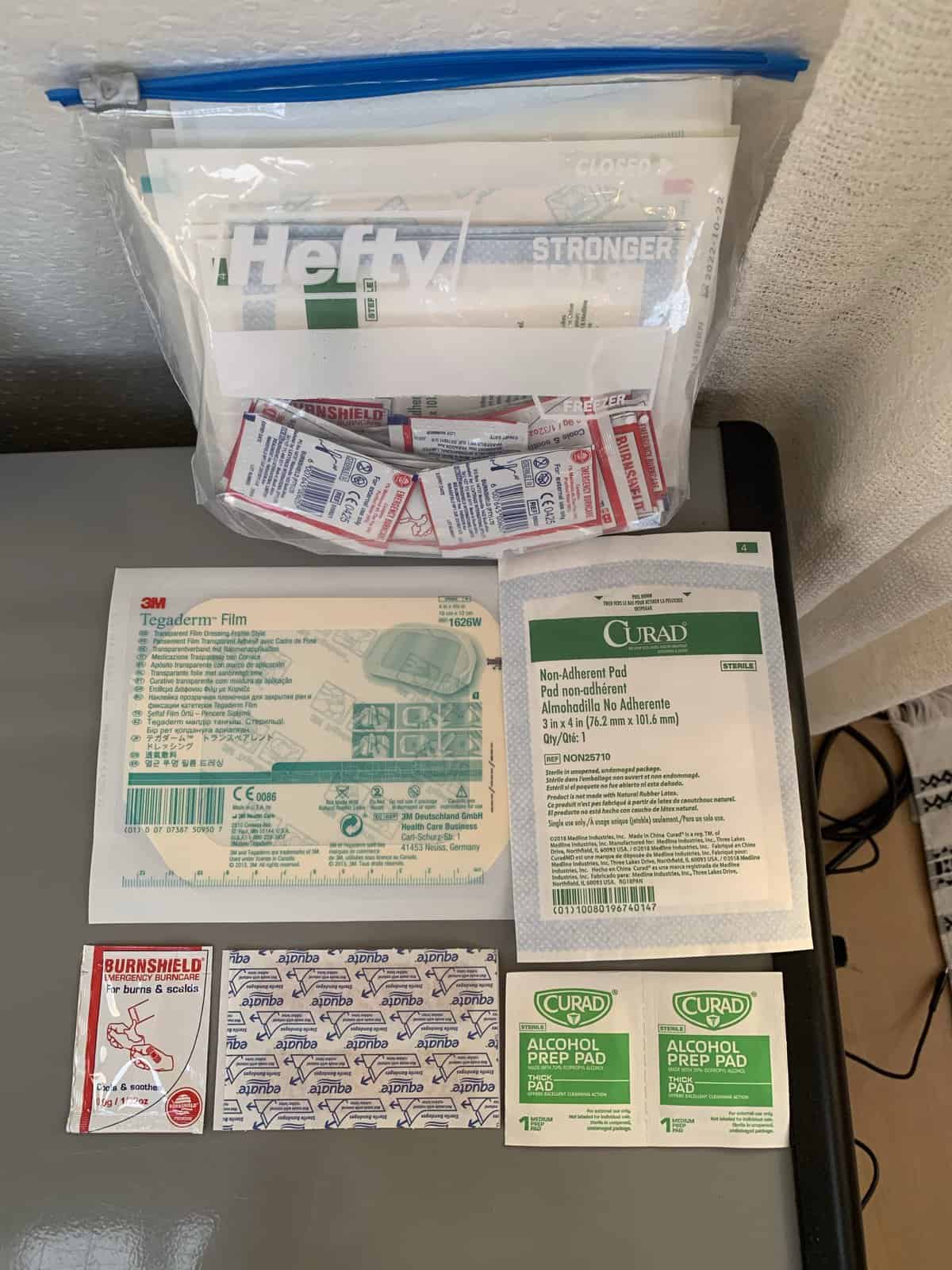
Links to order the items from the photo above:
- Tegaderm Film – excellent protection for cuts and wounds, especially with our adventurous lifestyle. It is like a second layer of skin and easy to come off.
- Non-adherent Pad – You must have these. They are excellent to protect a wound and will not stick to the skin.
- Band-aids – Buy a large package of various sizes.
- Alcohol Prep Pads – individually packed, perfect to quickly disinfect. Keep in mind, they are a bit small.
- Burn Shield – an ointment to help burns. I love that they are individually packed. I think we only used a couple of times, mostly for benign oven burns.
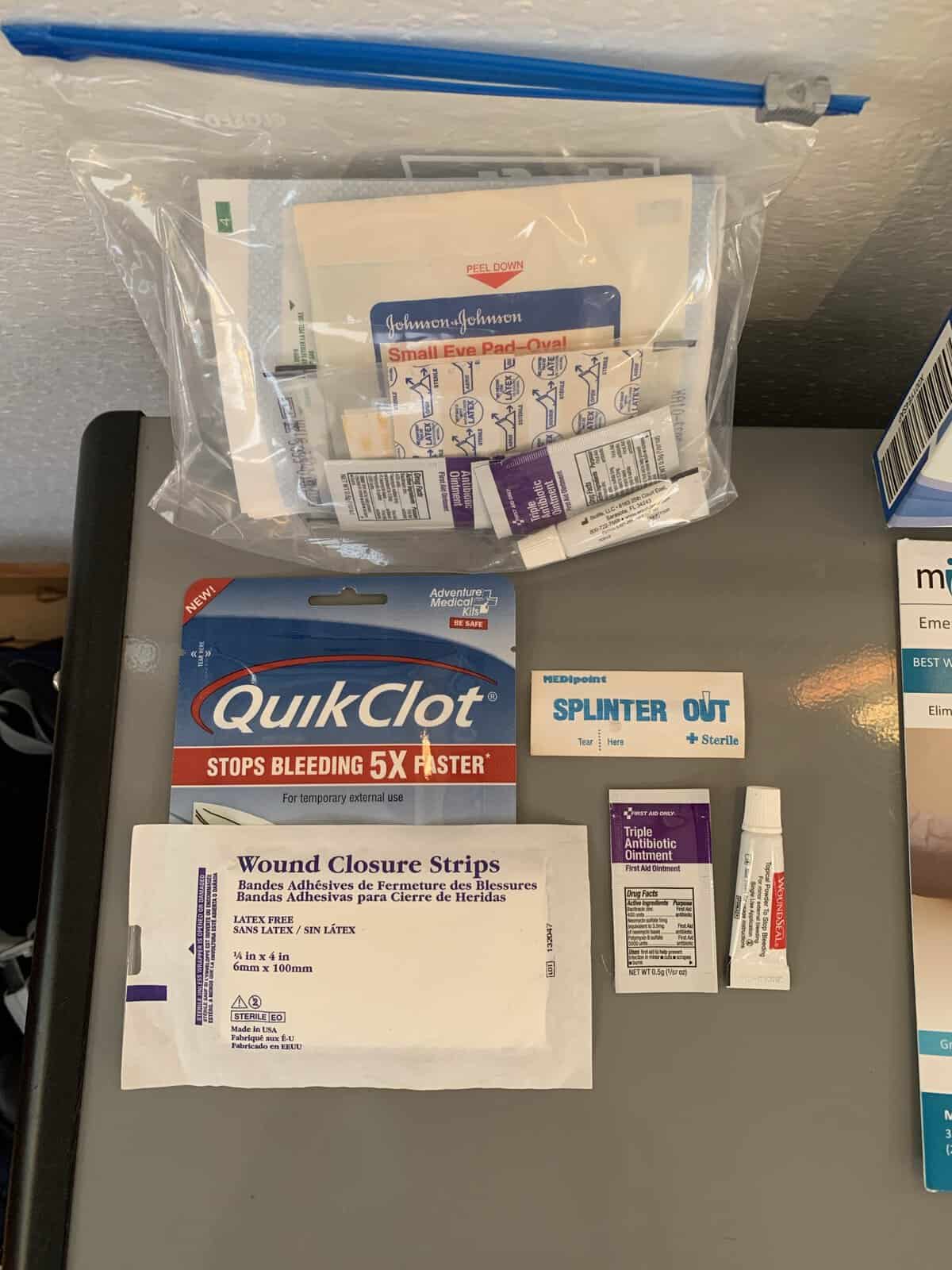
Links to order the items from the photo above:
- Quick Clot – special gauze that helps stop bleeding.
- Wound Seal – a small tube of powder to press on and stop bleeding.
- Wound Closure Strips – perfect for quickly closing small cuts.
- Splinter Out – my favorite splinter removing lancet.
- Tripple Antibiotic Ointment – individually packed – perfect for trips.
For wood disinfection and cleaning, we also have:
- Gauze – various sizes, or you can cut larger ones. Great to help clean wounds. After that, use a non-adherent pad to cover them.
- Iodine – keep it in a plastic bag, it stains. Topical only, read the instructions.
- Normal Saline – great for cleaning wounds, buy at least 1L.
- Plastic syringes – for wound irrigation – we had two, different sizes.
- Hydrogen peroxide – great for wound cleaning, not painful like iodine.
- Rubbing alcohol – we used the bottle aboard, the packs when out.
- Wound disinfecting spray – a small bottle, for the travel kit.
- Disposable Gloves – put a pair in your first-aid travel kit.
- Hand sanitizing wipes – to clean soiled hands, if no soap/water is available.
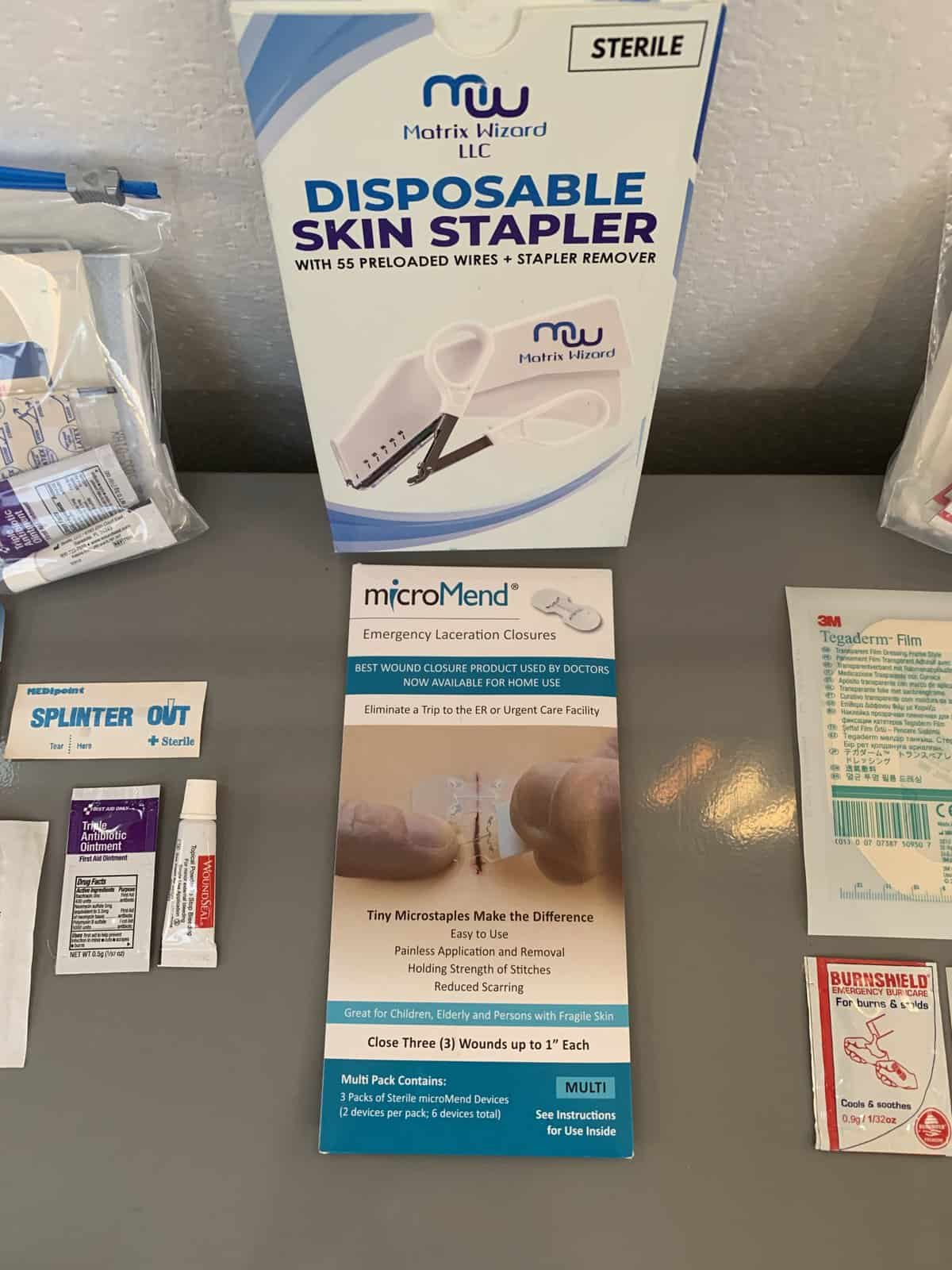
Links to order the items from the photo above:
- Disposable Skin Stapler – I thought of buying a suture kit, but I figured as fun as it would be to practice, in a true emergency, none of us is truly trained to stitch a laceration.
- Suture Practice Kit – still, if you want to practice, order one of these.
- MicroMend Laceration Closures – another quick closure option, stronger than the regular strips I have above.
Note: Specialized supplies are difficult to find in smaller countries, I would get everything before sailing away.
Stings and Allergic reactions
Stings, rashes, unfamiliar foods – opportunities for an allergic reaction are plenty.
With some simple supplies and common sense (“leaves of three, let them be”), unpleasant and dangerous situations can be avoided and managed.
When traveling to exotic destinations, I never know how everyone will react to new plants, animal life and foods.
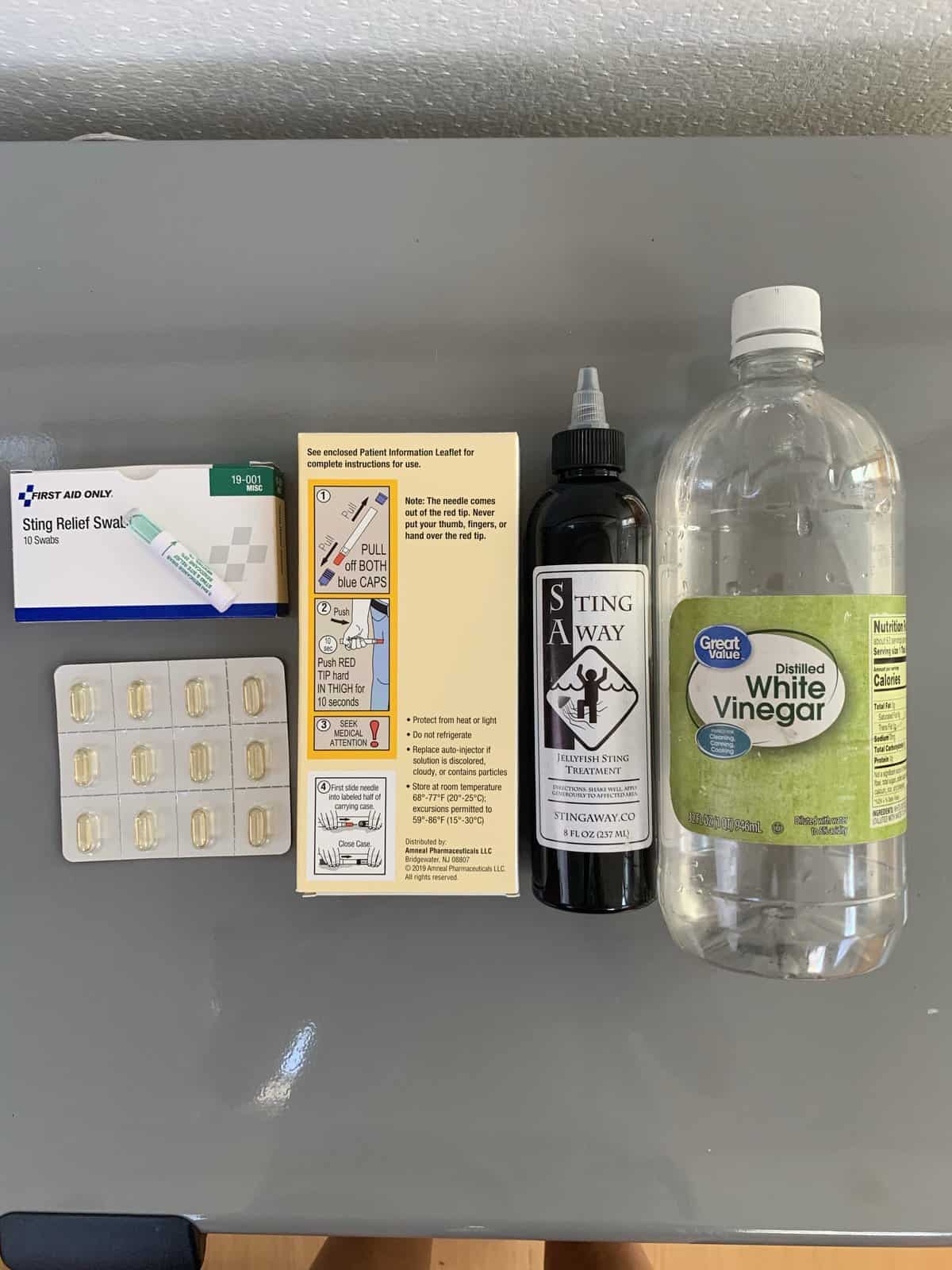
Links to order the items from the photo above:
- Sting Relief Swabs – very easy to throw in the first-aid traveling/hiking kit. We used once, they are OK, nothing too spectacular.
- diphenhydramine HCl (Benadryl in the US) – I always have at least 50mg on hand. I have had to use it three times already.
- epinephrine injector (epipen) – with prescription only, we did have a couple aboard. Noone in our family has severe allergies that we know of, but my grandma is severely allergic to bee stings, so I am always a bit cautious.
- Sting Away Jellyfish Treatment – nice to have aboard, but difficult to carry around. We tried it once and liked the vinegar better.
- Distilled White Vinegar – I have used it more times than I can count, works like a charm. Soak gauze, or paper towel and keep reapplying.
- 1% Hydrocortisone cream – easy to find in any drug store. Anti-itch cream can help prevent scratching, which can lead to broken skin and infection. It’s the only reason I use it.
Vinegar is one of my most favorite medical supplies aboard.
When the kids go swimming, there are occasionally those seaweeds with miniature jellyfish inside. They would come out of the water covered in rashes.
A quick vinegar rub and the rash is gone. So they can jump back and do it all over again…
We also use vinegar for all sorts of cleaning chores aboard – from the galley through the washing machine, to the composting head – safe for wood and for the ocean.
Here is one of those times, we had to use all anti-sting supplies aboard, at a desolate island.
Our YouTube episode featuring the nasty jellyfish stinging at Coffin Island.
Tip: Wear a long sleeve rash guard and even rash leggings when exploring rocks, underwater caves, or spear fishing. Don’t ruin your fun snorkeling trip.
Seasonal allergies were never an issue aboard. We have two in the family who normally take Claritin every other season.
Once we moved aboard, all seasonal allergies disappeared!
Sunburn and Rashes
I vote for covering with clothes, rather than sunscreen. But we have both options.
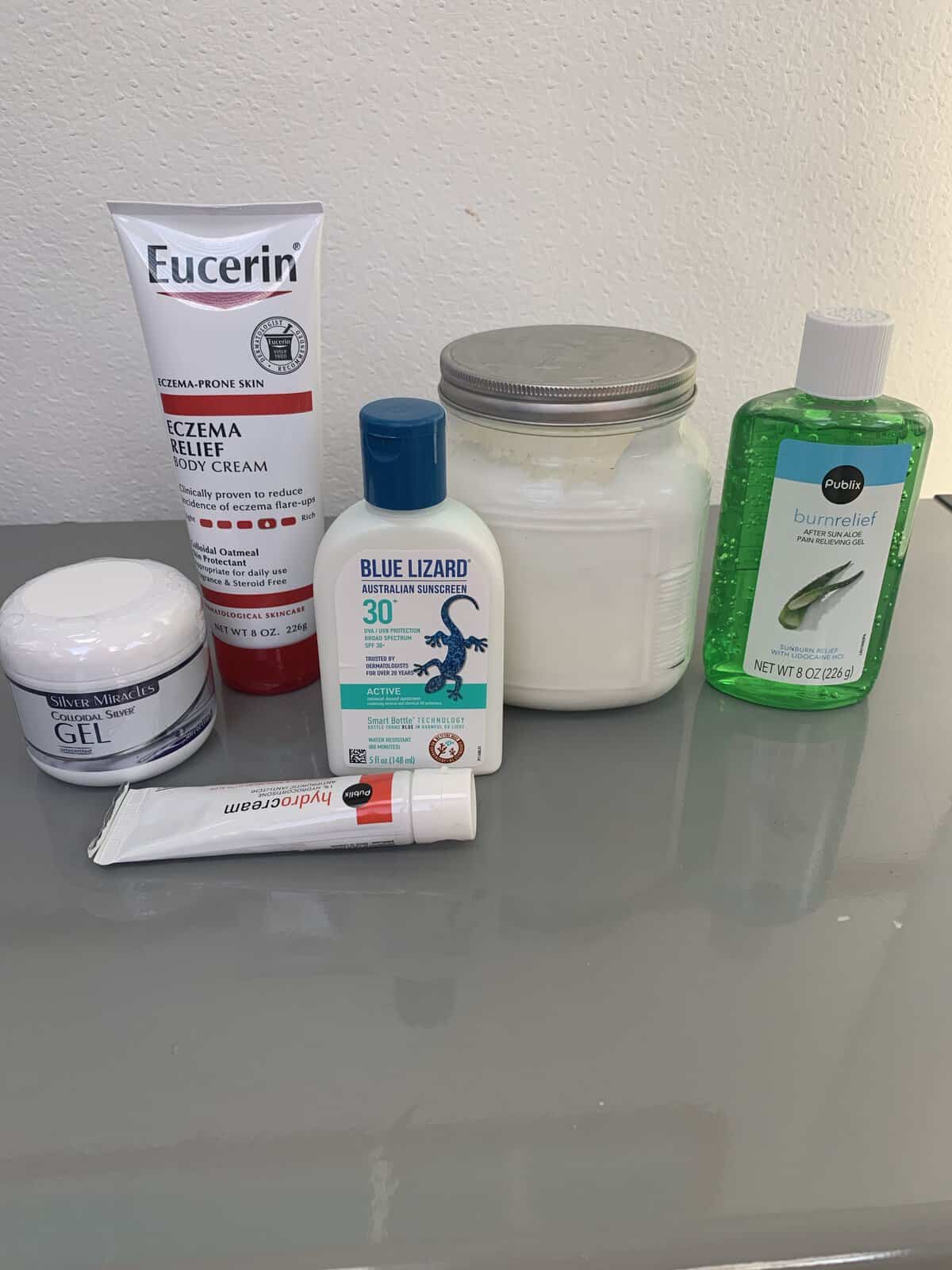
It is difficult to make the kids wear their long sleeve rash guards when it is in the 80’s F outside!
Still, you will not see us much sunbathing in bikini. We live aboard, we are not on vacation. The red ones walking around are all tourists, fyi.
Links to order the items from the photo above:
- Colloidal Silver Gel – for burns and sunburns. As I very much police the sun exposure aboard, we have not had any sun burns requiring treatment.
- Blue Lizard Australian Sunscreen 5ml – a mineral sunscreen, which the kids hate and I love, so that’s what we have.
- Large sunscreen 1 gal – we had a giant tub of Blue Lizard 1 gal, with a pump. I used that to refill the small container, which we carried on land trips. It is hard to find it online, so you might have to shop around. Amazon does not carry it any longer.
- Eczema Relief – we have never needed the ointment so far, but we do have someone prone to eczema. Again, different climates and environment might trigger different reactions.
- Aloe gel – the universal sunburn relief gel. We had plenty of it, for guests. I don’t think we ever needed it (Fun Police made sure people hid from the bad sun).
- Plain yoghurt – the universal anti sunburn treatment in Bulgaria. Works great. Apply generously, leave to dry and rinse. Grab some with granola, while at it, it’s tasty.
Note: Please, do not use spray sunscreen aboard. It is hard to clean and can discolor some surfaces.
Earaches
Kids are in the water all the time. Sooner or later someone is prone to have a swimmer’s ear.
We actually had a swimmer’s ear, which turned into a full-blown middle ear infection (acute otitis media), because I was a bit too casual with it at the beginning.
Prevention is key!
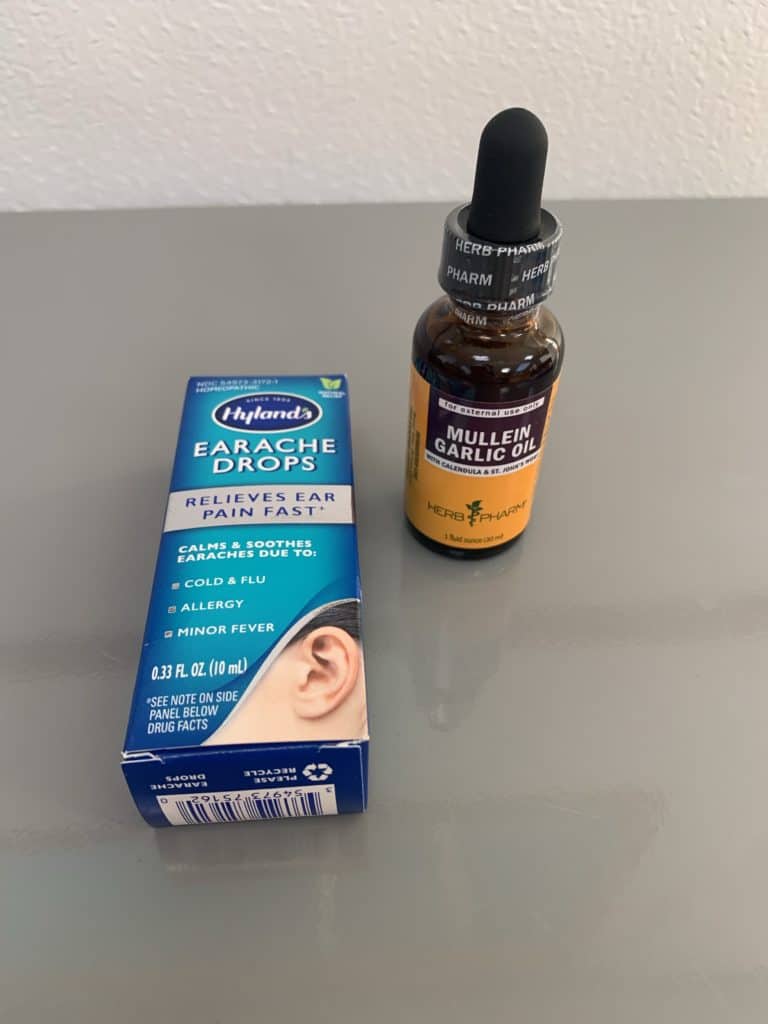
Links to order the items from the photo above:
- Mulein Garlic Oil – preventative care, will not cure an active infection.
- Earache drops – because earaches are the worst!
- Antibiotic + steroid ear drops – prescription only (in the US) – excellent to treat outer ear infections (swimmer’s ear).
- Alcohol and vinegar – the single most effective prevention I have tried countless times is a mixture of half distilled vinegar and half rubbing alcohol; make it yourself.
Just a few drops of alcohol/vinegar in each ear as soon as they are out of the water is enough to help dry out the ear canal and prevent bacteria from growing.
Toothaches
There are no shortcuts when it comes to dental help. If you have a tooth ache, go to the dentist.
Thankfully, excellent dental care has been easily available in foreign countries, at a fraction of the cost of US dental clinics.
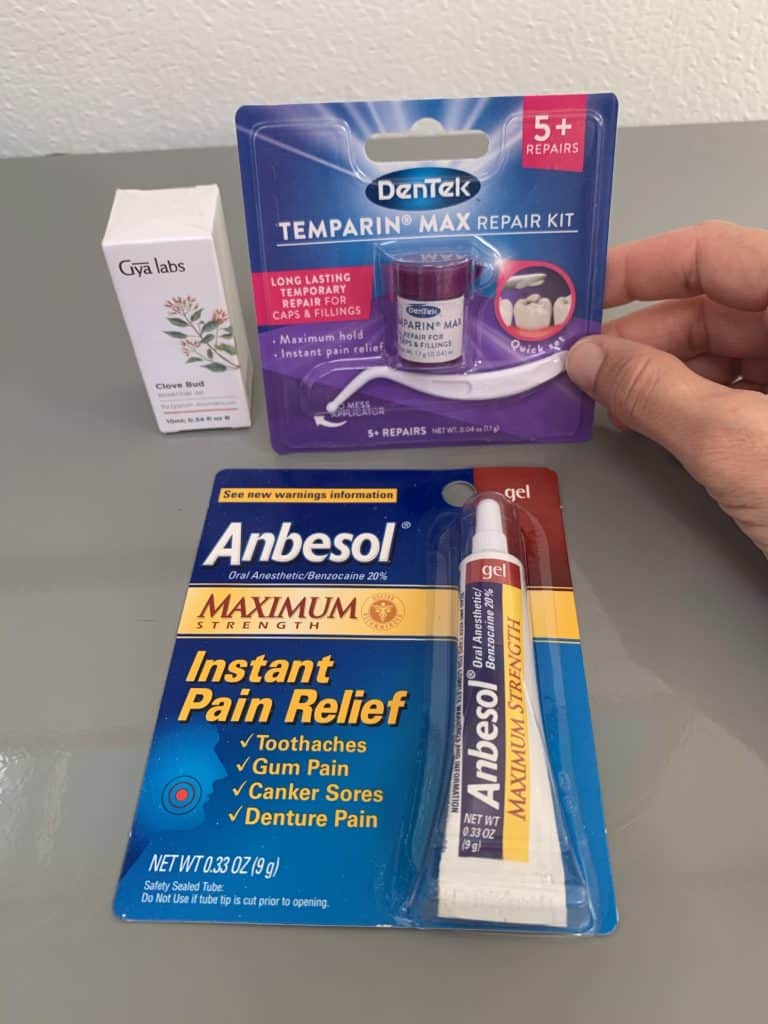
Links to order the items from the photo above:
The items in the photo are just for temporary help. Tooth infections and cavities do not resolve on their own. Get dental help as soon as you can.
- Clove essential oil – we never used it, but it came highly recommended, so I purchased a pack. It does not hurt to be prepared. It is also used for period cramps.
- Max Repair Kit – if you need to temporarily fill a cavity, this can help. Again, dental care was available everywhere we cruised, so we did not need it.
- Anbesol Pain Relief – a quick and temporary pain relief.
We have had very few dentist visits in the US. We do all of our dental care in Bulgaria, as we visit every year.
Our boater friends have fixed and cleaned teeth in the Dominican Republic, Mexico, Guatemala – all loved the care, the quality and the prices.
Local Pain Relief
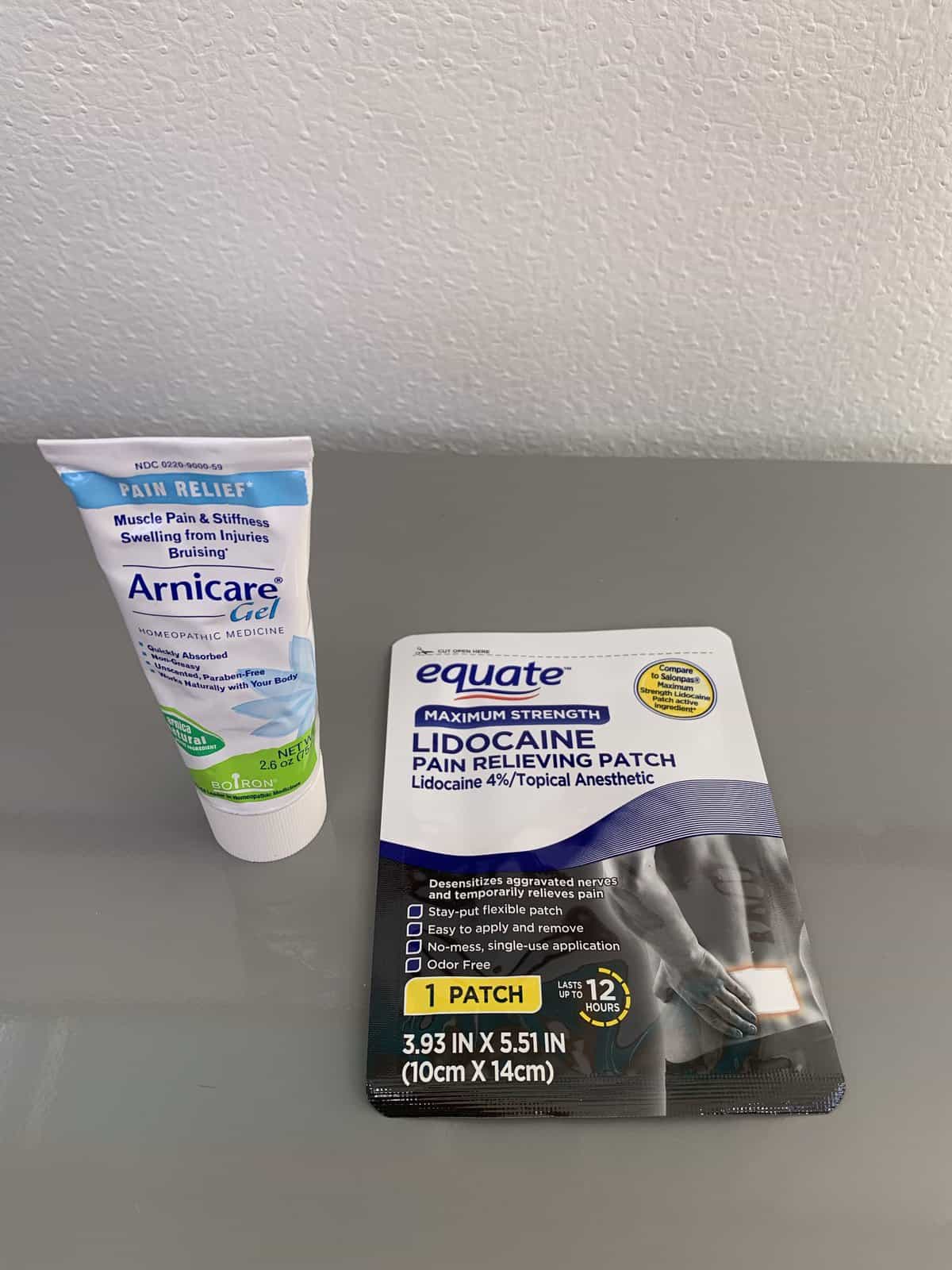
These ointments will work OK for some milder pains and stiffness. They will not be effective for more serious pains, sprains, or bruising.
Links to order the items from the photo above:
- Arnicare Gel – we have tried it with mixed success. It does help, for milder aches.
- Lidocaine Patch 4% – again, OK for milder aches.
If you experience more serious trauma, seek medical help as soon as possible. All of the places we sailed to had access to a medical professional (minus the small, desolate islands).
Pain Medications
As far as headaches, cramps and common pain management – we use over-the-counter (OTC) medications.
Acetaminophen (Tylenol) and ibuprofen (Advil) work very well, and I have been giving them together (instead of alternating), for better results.
Check with your provider for combining for kids, based on age and weight.
In Europe, paracetamol is used instead of acetaminophen.
I also keep aspirin aboard (the so called “baby aspirin“, 81mg), but only for adults. Aspirin should not be given to children (refer to the package instructions).
Tip: Learn the generic names of all your medications. Trade names are different in other parts of the world.
Seasickness, Diarrhea and Stomach Issues
From seasickness, through diarrhea, to constipation – we have dealt with them all. It is best to handle them quickly, because they suck!
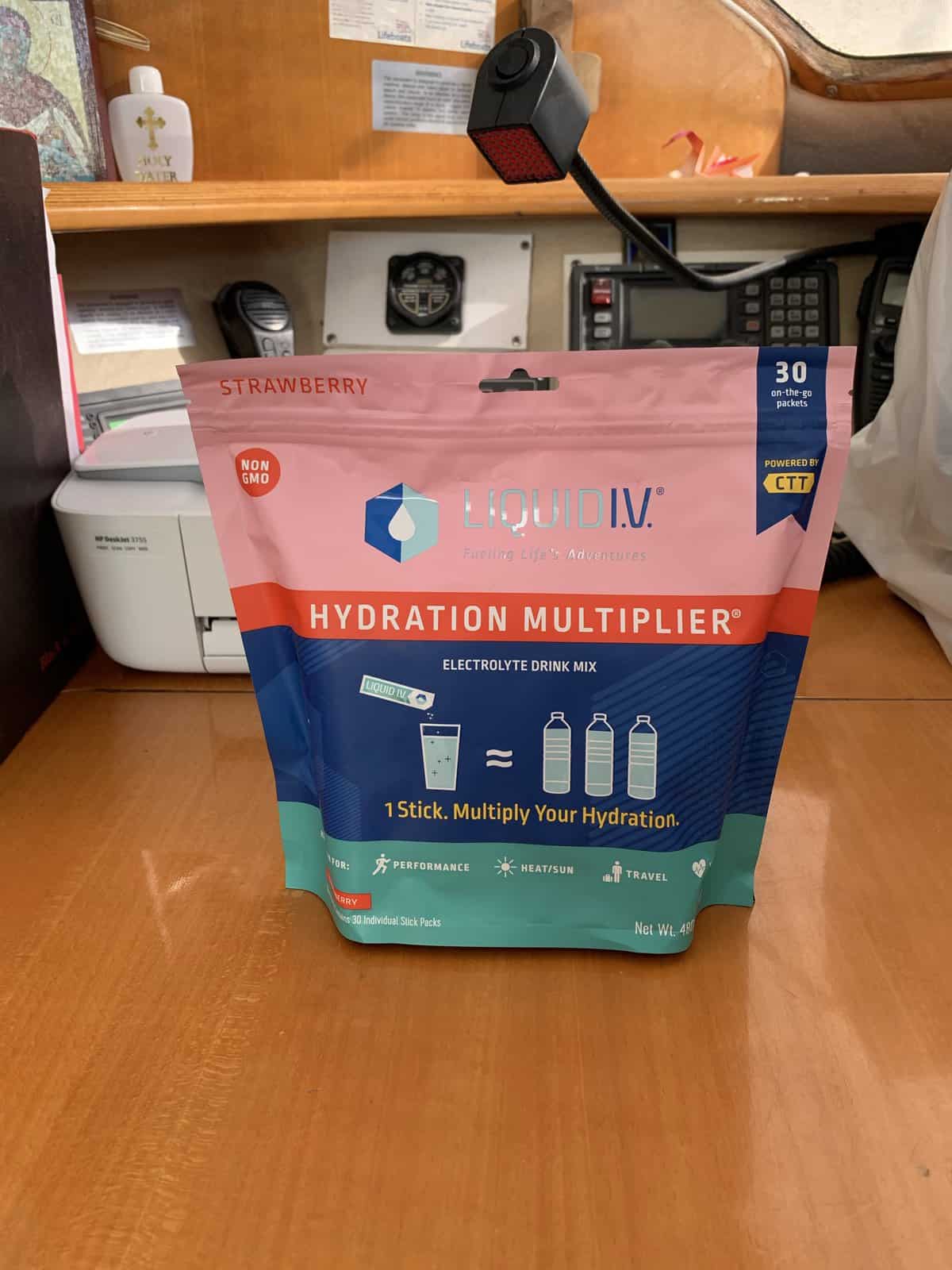
Links to order the items from the photo above:
- Liquid I.V. – can be used for any situation requiring hydration – stomach bugs, diarrhea, fevers, etc. Individual powder packs are perfect to take along on land trips.
- Anti-diarrhea medication (Loperamide Hydrochloride) – works great for persistent diarrhea. Trade name in the US is Imodium. Please check with your provider and read the instructions.
- Digestive help (Bismuth Subsalicylate) – known as Pepto Bismol in the US. A genral and effective help against heartburn, indigestion and antidiarrheal.
Seasickness is a given, so I have a couple of helpful posts about it:
Seasickness Sucks – 21 Tried and Tested Tips to Stop it.
10 Seasickness Questions – Answered (by a Boat-mom).
Sprains, Strains and Breaks
We have all gone limping around on the boat. With so many unusual parts sticking out here and there, and the boat moving on top of that, graceful strolls aboard take practice.
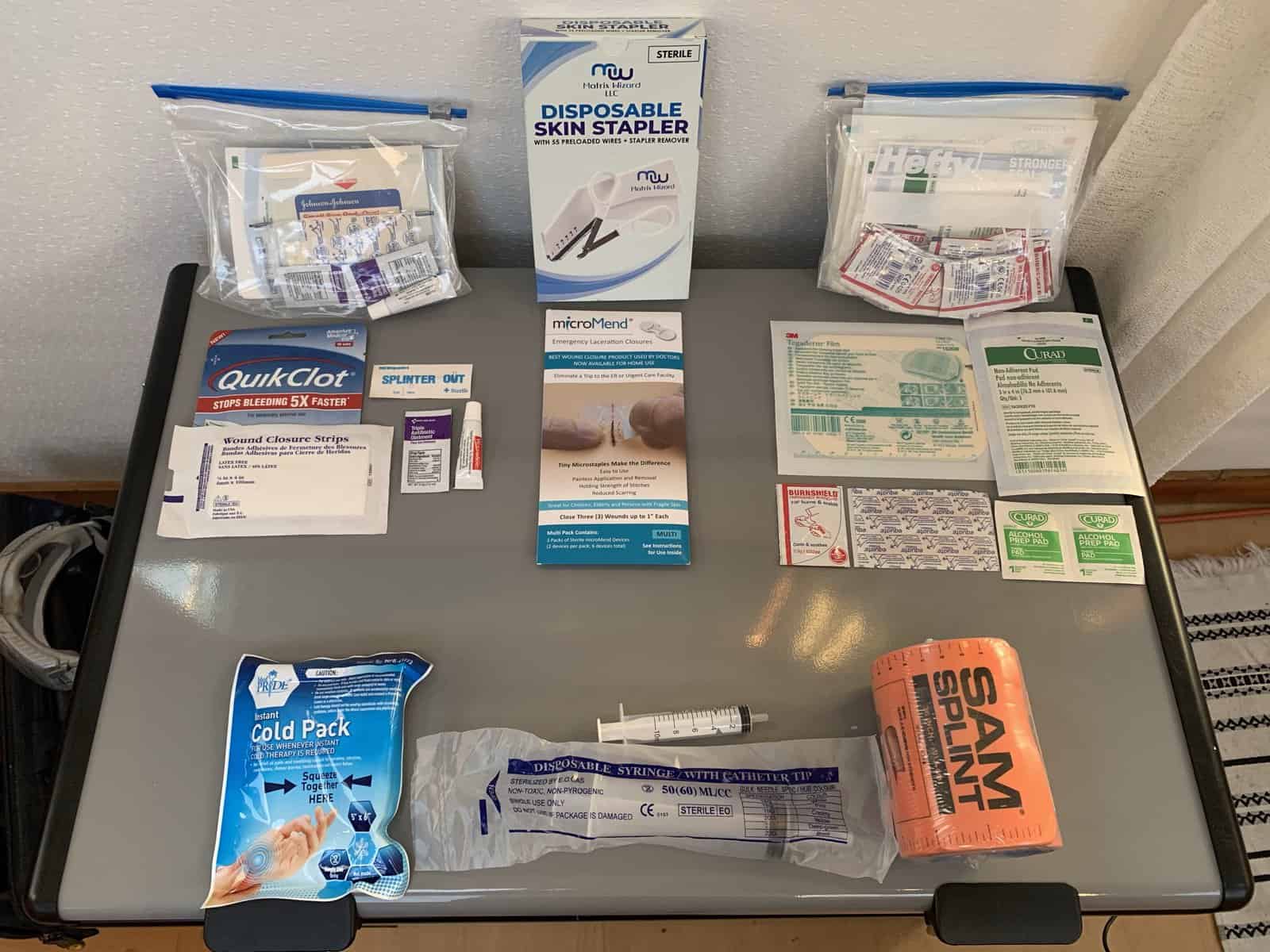
To be prepared for minor sprains and at least temporary help for not-so-minor injuries, I bought supplies anyone could use aboard:
Links to order the items from the photo above:
- Instant cold packs – they are perfect for hikes and land trips.
- Gel ice packs – ideal to keep in the freezer aboard.
- Elastic bandages – great for wrapping limbs to secure them, with some minor twists and sprains.
- Ankle Support Brace – adjustable and breathable.
- Wrist Support Brace – make sure you get one for both right and left hand.
- SAM splint – it molds into shape to hold a broken limb in the optimal position, until help is reached.
I love the SAM splint. I had opportunities to use it at a summer camp, where I worked as a nurse for one summer. Here is a useful video how to use it:
SAM Splint Intro and How to Use – YouTube
Anti Lice Measures
I hate lice.
But lice happen. And when they do, they have to be dealt with swiftly and mercilessly.
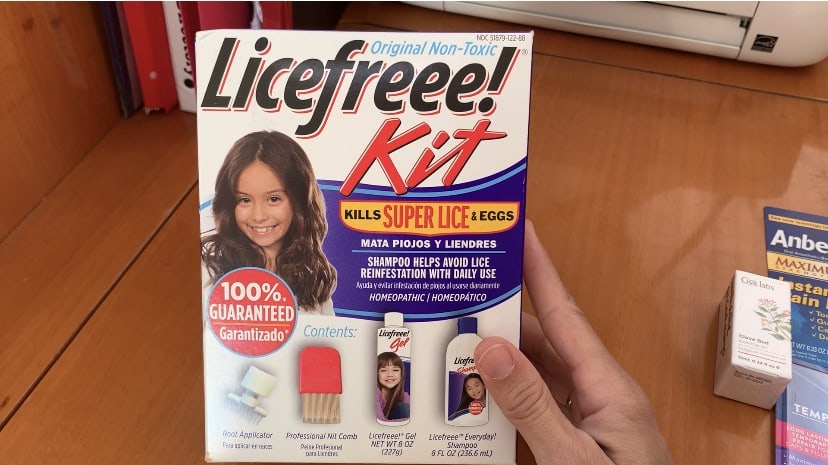
Lice like warm, humid climates. Lice can also be picked up at the movies, trampoline parks and fabric headrests in public transport.
Links to order the items from the photo above:
- Rosemarry Shampoo – can help prevent lice, they do not like the smell. I do. The set lasts quite a while, I think we used it for over two months.
- Licefree Kit – bring at least two. If one person gets lice, chances are at least one more will follow.
My grandma used a mixture of heated lard and gasoline, which kills everything! It is great for the hair and stinks for a week!
It is best to avoid lice altogether:
- Cover the headrest of a bus/train with the outside of your jacket, or a sweater.
- Do not exchange hats and hair accessories with others.
- If someone has lice aboard, find a laundromat and launder and dry everything on hot, twice.
Intimate care
With hot and humid climate, fungus and yeast thrive! Buy some OTC yeast infection remedies.
I am also a fan of the cup, rather than pads, or tampons.
- Menstrual cup – perfect for hot and humid climates. Easy to use. I have zero complaints.
- Yeast Infection Treatment (miconazole 4%)- just buy a couple, put away and forget about them. If you need them and do not have them, it is a pain.
Note: Sharks are not attracted to human blood. Read my helpful post:
Worried About Sharks in the Bahamas? 10 Tips for a Safe Swim.
Antibiotics
The most important antibiotics to have in your first aid kit aboard are cephalexin and amoxicillin.
Cephalexin (Keflex in the US) is taken for blood infections, which can start through infected wounds. Such as cuts from a sharp shell, choral, glass, etc.
Ah, here is a good place to suggest some boating shoes:
Comfortable Sailing Shoes for Every Boating Need
A broad-spectrum antibiotic, such as amoxicillin is usually prescribed for other infections, such as an inner ear, lung, and others.
Based on your medical history and allergies, antibiotics may vary. Talk to your provider for the proper antibiotics for you.
Prescription Medications
Have a small supply of your routine prescribed meds, in a small bag. Put the bag in the ditch bag before passages. Then take out, once the passage is over.
Ask for a longer prescription of the medications (such as a six-month supply). Some pharmacies will not dispense more than 3 months at a time, keep that in mind.
We now buy all of our prescription medications abroad.
Learn the generic names of any prescription medications. Trade names are different in other parts of the world.
Note: Common prescription medications are easily filled in other countries. Such as high blood pressure pills. More specialized medications might be hard to find abroad.
Organizing the supplies
The sooner you organize the medications and supplies, the better. For three reasons:
- They should be readily available, when needed.
- Moisture and mold love cluttered boxes and drawers.
- Seeing what you have will prevent you from buying extras unnecessarily.
Medicine Cabinet
Reachable by anyone aboard, it is a plastic three-drawer cabinet from Walmart.
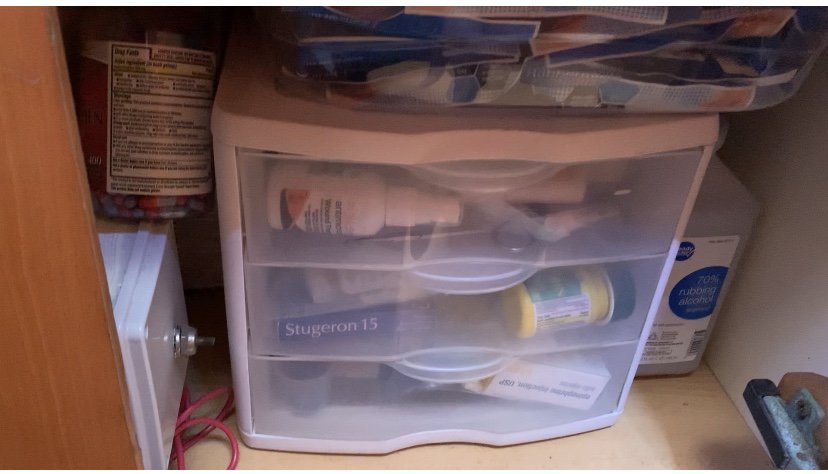
After trying various compartments, plastic seemed to be the easiest to clean, protect items from mold and it does not rust.
It contains everything a land house might have.
I throw in a couple of silica gel packs in each drawer, as well as in the pill containers for help with humidity.
Silica gel packs go with many of our gadgets as well.
If you have younger children, put a child’s lock on the boat cabinet, rather than trying to find a hard-to-reach place for everything.
Travel Kit
We have a small first aid kit aboard, containing items needed to help a person quickly, mostly for small wound care, pain and allergic reactions.
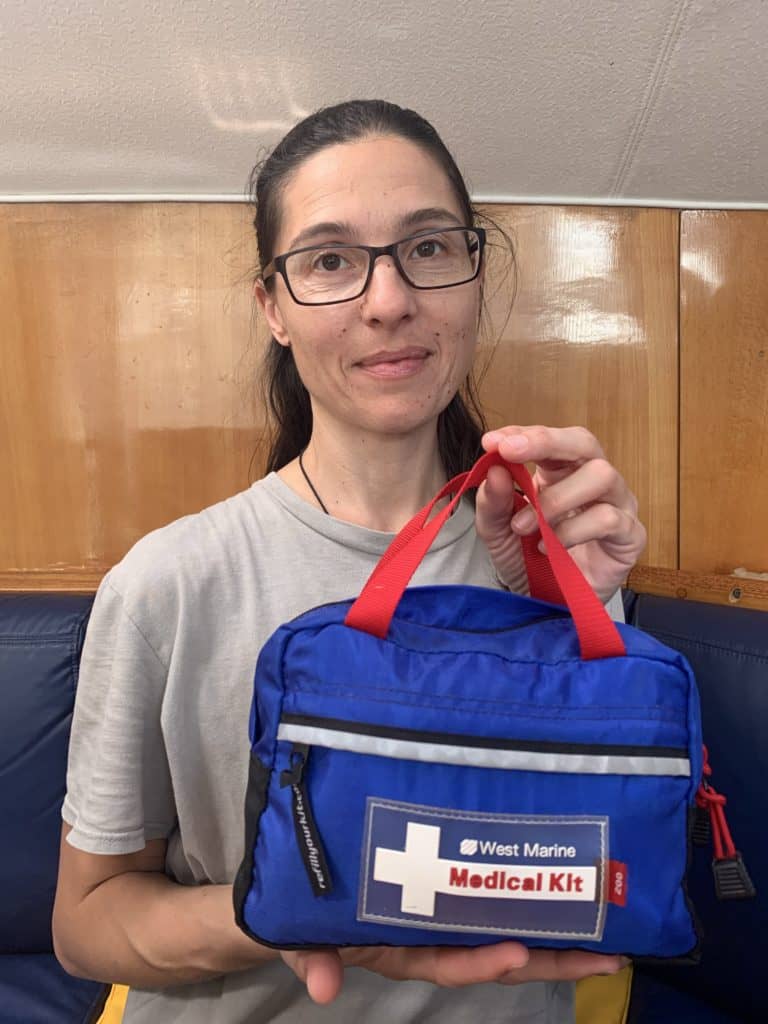
I take this bag whenever we go out to shore, or during land trips, where medical care is available.
This has been our first aid kit to fly with as well. It can be purchased pre-filled, but it is more expensive.
Here is a link to a pre-filled one, if you prefer that: Cruiser First Aid Kit
Even though we have a dedicated cabinet aboard, the kids are so used to the small bag, that whenever something is needed, they just grab it from there.
If that is the case in your family, remember to restock the travel kit. Or put it away, so everyone can use the cabinet instead.
Ditch Bag Supplies
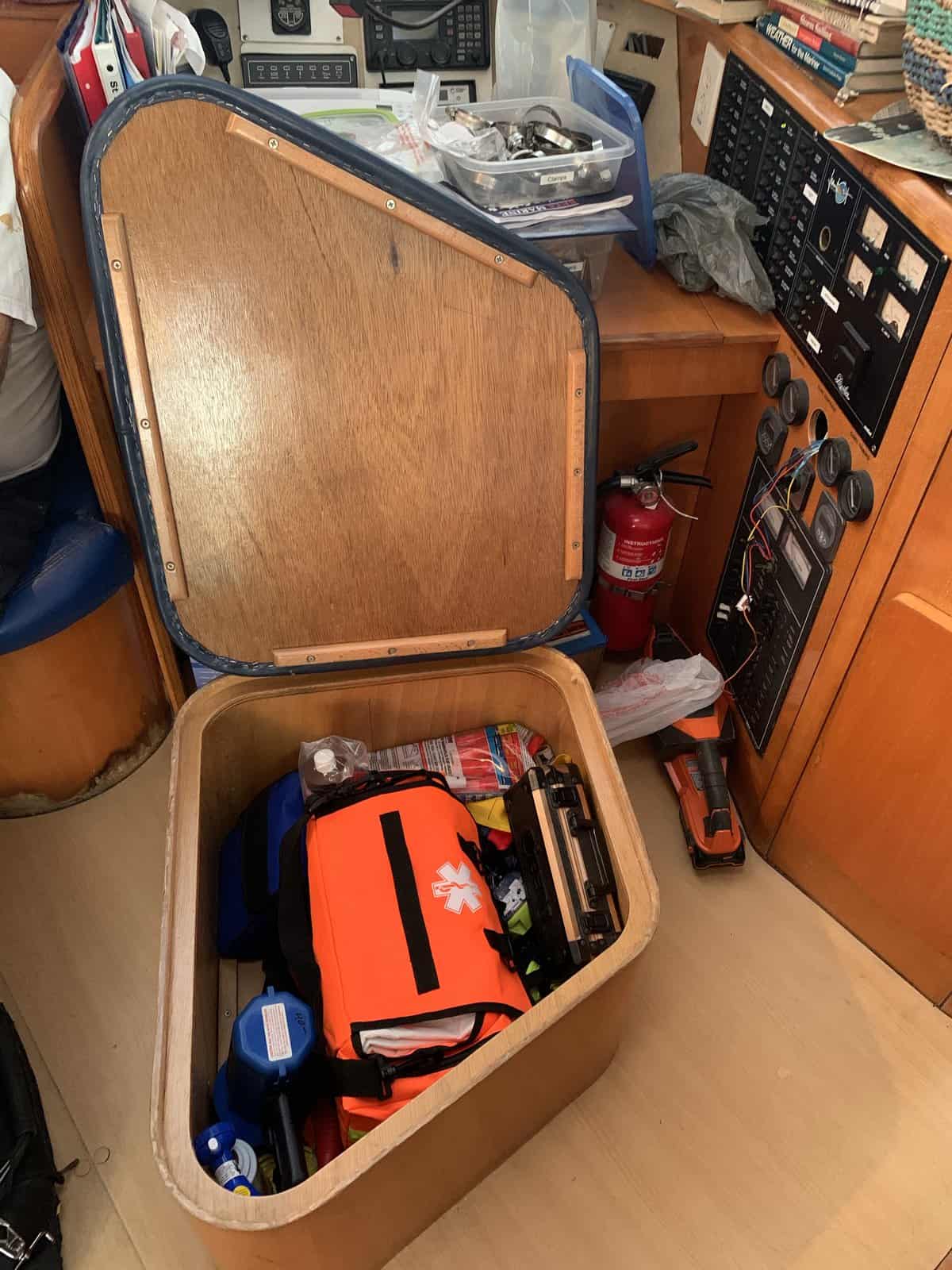
That one would be grabbed if we had to go into the life raft and abandon ship, or we planned a longer wilderness adventure.
It is located in the salon, easily accessible.
Note: This bag contains the supplies to throw into the ditch bag. This is not the ditch bag.
Here are great options for ditch bags in this post:
19 Best Boating Bags. Tips How to Use Them.
Stock Box
Finally, we also have a clear plastic box with a bunch of extras, to refill the various bags as needed.
Put a few silica bags into that box, because it will be the one you open less frequently.
Courses and Trainings
At least two mature individuals aboard must be first aid trained.
I have an entire post about valuable courses and trainings to consider before cruising away:
11 Valuable Boating Subscriptions and Courses
What we do Not Have Aboard and Why
AED
Even though they are an essential part of every CPR, BLS and ASLS course out there, using an AED is a step in the process of emergency care, not the solution.
True, if we are in an area, where emergency help is available, it can help save someone’s life, while waiting for the ambulance.
We did not keep an AED in our land house, so we chose not to have one at our sailing home.
We do know cruisers who have purchased them, so it is a matter of personal preference.
IV start kits and fluids
I wasn’t able to find needles online, only the tubing and bags. I’d love to have something to replenish lost volume due to bleeding, for example.
Now, will I be able to find a vein and start an IV on a loved one, in an emergency?!
I have no clue.
Prescription pain medications
To be perfectly honest, I was just too lazy to find a prescription and purchase stronger pain medications.
Having said that, I have given post-surgical patients acetaminophen. The OTC pain medications are pretty potent.
So, for us, ibuprofen, acetaminophen and rum it is! Do not mix alcohol with medications, please. The rum thing is a joke.
Intubation kit
My nursing skills don’t include intubating and extubating a patient, so I decided not to buy supplies, but it is something other nurses and physicians carry, on the water!
Try to anchor next to boats with doctors, or ICU nurses aboard!
What we always have
Did I forget to mention what we have consistently used, and with absolutely no side effects? I do have stories to share too.
Medications matter, but they can only go so far alone, so we heavily rely on prayers!
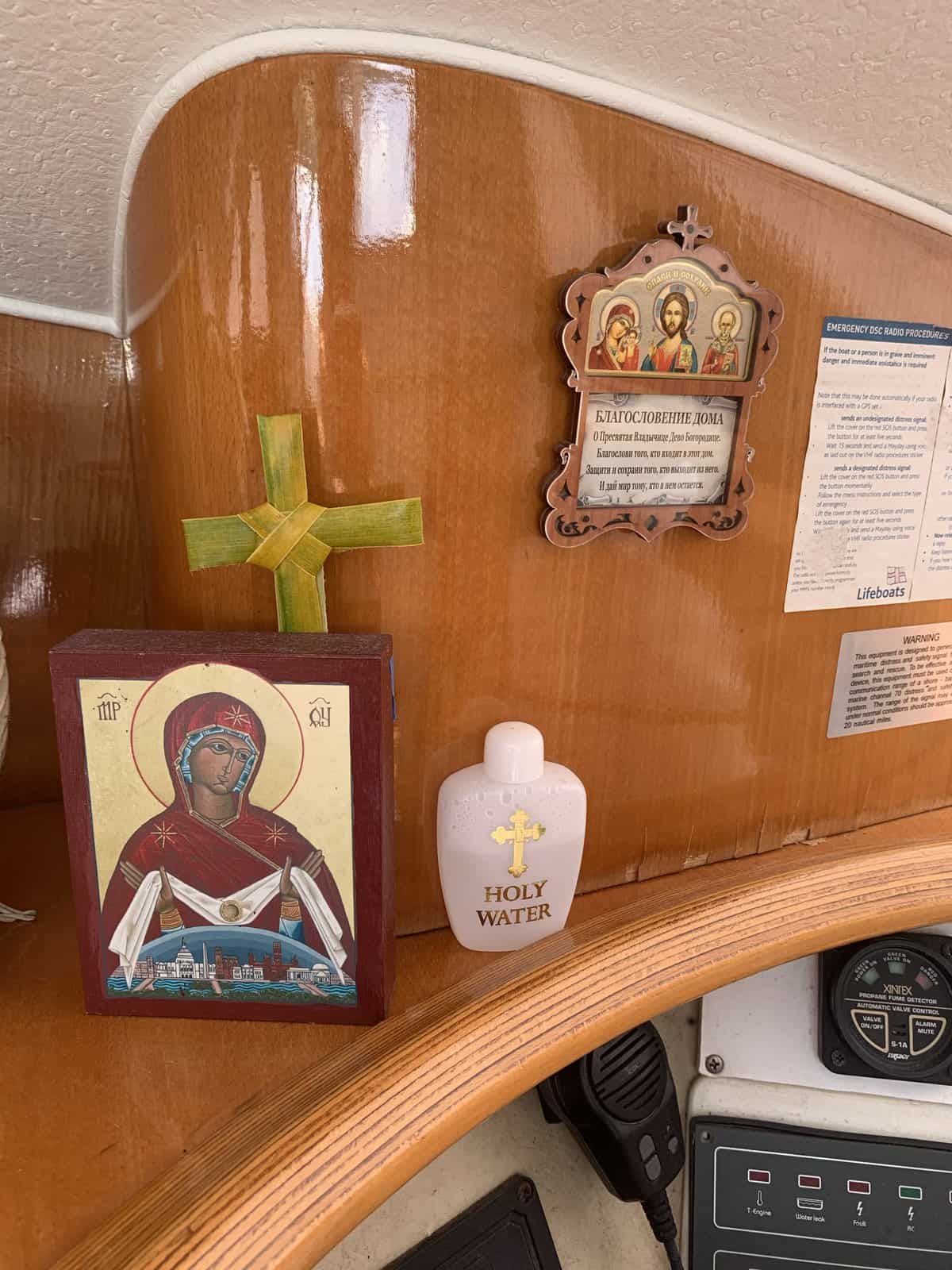
To Summarize
It is not difficult to prepare and organize your own first aid kit aboard. I hope my photos and tips helped you feel a bit better prepared.
Organizing and researching medical supplies is not super fun, but it must be done.
The majority of cruisers, including us, end up using just a handful of medications and ointments aboard. There is no need to stress unnecessarily.
Am I not covering something you are curious about, send me an e-mail and let me know.
More essential boat gear
What is a PFD? Easy Guide and Common Questions.
12 Safety Gear Essentials for the High Seas.
10 Most Reliable Sailing Life Jackets (Adults and Kids)
27 Important Tools for Boaters
Posts related to Health and Safety Aboard
Worried About Sharks in the Bahamas? 10 Tips for a Safe Swim.

Aloe and such for sunburn?
Goodness, I must have deleted an entire paragraph, suncare was there! Thank you for noticing! I’ll update it. Yes, we have a combination of sunburn ointments and a huge tub of sunscreen!
There are so many details to consider! Georgia will bring her EpiPen just in case. What do you think of the hydration multipliers? Have you used them before?
I have not used this particular kind. I have used similar ones. We will see once we open them! We are trying accommodate Grandma during our Bahamas trip, but it is difficult, because we have no idea where we will be at particular times next few months.
AeroMD I believe it costs $350 per year for family which if needed to get flown to either Puerto Rico or a hospital in main land USA(Miami). From anywhere in the Caribbean.
Noted! Thank you. We do have a healthcare share plan, which is good anywhere in the world, but the med-evac and transport is always a grey area, as it can be very expensive! I’ll look into options once we make it out of St. Augustine Marine Center!